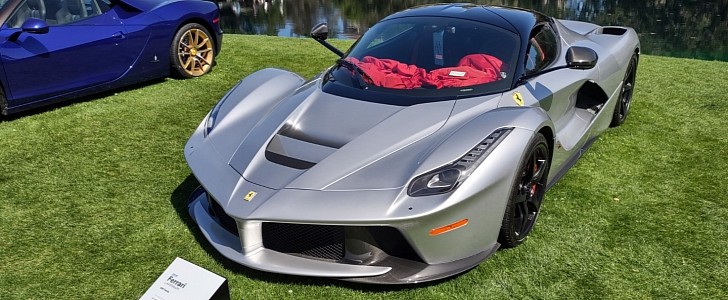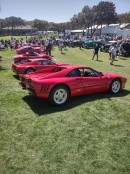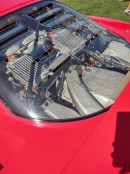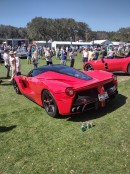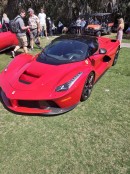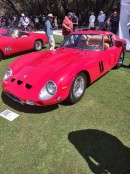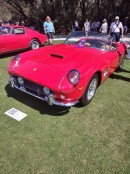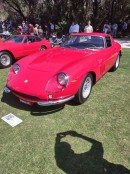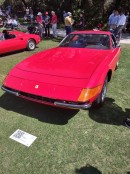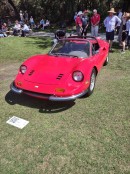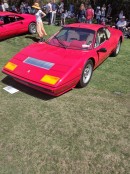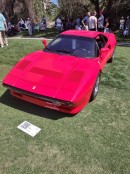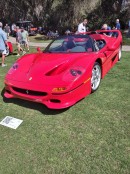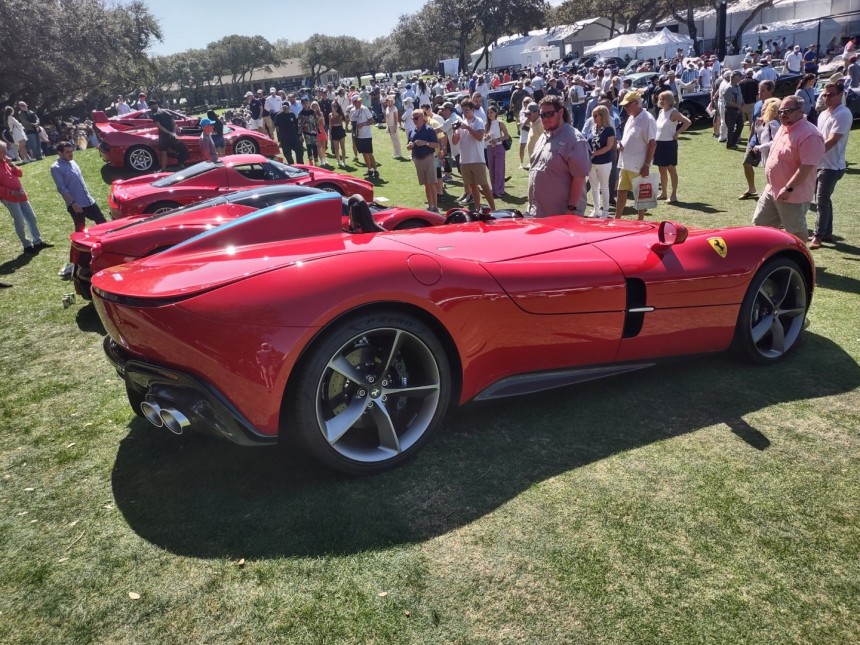Nothing stirs the hearts of drivers more than a lineup of Italian exotics, that’s why these masterpieces from Maranello made their way to a sleepy island in Northeast Florida.
Readers be warned, these images are not for the faint of heart. They represent seven decades of street legal performance that financed the world’s most recognizable racing team. Enzo had one goal in life: Win Races. In order to do so, these halo cars were released every few years to bring the public into their exclusive dealer network.
1958 250 GT LWB Berlinetta The Ferrari 250 series comprises the most expensive privately-owned cars in the world. Each example is worthy of an encyclopedia unto itself, so here are the basics. Built from 52 to 64, they introduced the world to an indestructible 2.9-liter V12 designed by Gioacchino Colombo.
1962 250 GTO Built to homologate Group 3 racing, their sticker price of $18,500 was equal to 4.6 new Corvettes. Luigi Chinetti was the sole North American dealer, and each example had to be approved by him and Enzo before the deposit was accepted.
1963 250 California Spyder Ferris Bueller had great taste in cars, and they were worth a small fortune even back in 86. The Amelia auction held by Gooding & Company back in 2016 set the asking price at $17,161,000. Designed for Americans, Scaglietti sculpted a body of aluminum, but steel was used for most parts. The engine was borrowed from the 250 tour de France, offering 237 horsepower to their SWB (Short Wheelbase) chassis.
1967 275 GTB 4C More power was needed, so the V12 was enlarged to 3.3 liters and fitted to a longer/wider chassis. The first Ferrari to arrive with a rear-mounted transaxle also introduced their independent rear suspension. From 64 to 66, the early engines were single overhead cams (GTS, GTB). Dual overhead cams arrived for 1967, offering 300 horsepower and a top speed of 167 mph.
1971 365 GTB/4 After winning 1-2-3 in Florida, it became known as the “Daytona”. Launched to compete with the Miura and the C3 Corvette, the engine was bumped to 4.4 liters to offer 347 horsepower. Reaching 60 mph in 5.4 seconds was impressive, but American examples had lower compression and a restrictive exhaust.
1973 246 GTS Don’t call it a Dino! Ferrari’s entry-level sports car was designed and named by Enzo’s son Dino. After designing an amazing line of powerful V6 engines, his life was cut short by muscular dystrophy. Alfredo “Dino” Ferrari was only 24 years old, and his legacy can be seen in the new 296 GTB.
1985 BB 512i Seeking a low center of gravity, the Berlinetta Boxer is powered by a flat 5-liter twelve cylinder (512). Their first mid-mounted powertrain was introduced in 73, with a run that included the Testarossa and its successors until 1997.
1985 288 GTO Underappreciated at the time, Enzo’s quest to dominate Group B rally racing was cothed in a body that looked very similar to their normal production 308 from 1985. Weighing in at 2,555 lbs (1,158 kg), it used IHI water-cooled turbos from Japan to offer 395 horsepower and 366 lb-ft (496 Nm) to reach 189 mph.
Ferrari F40 Lessons learned in rally racing easily translated to a superior track car. Pushing turbo technology to new limits, the 2.9-liter V8 offered 471 horsepower and 426 lb-ft (577 Nm). The air conditioning works when it feels like it, but you will have no audio, power windows, mufflers, or catalytic converters. Not bad for $400,000 in 1987.
F50 Only 349 cars were offered between 1995 and 97, which puts it in an odd spot vis-à-vis its contemporaries. If you like shifting gears, this is Ferrari’s farewell to the clutch pedal. The 4.7-liter makes use of 5 valves per cylinder to offer a screaming redline of 8,600. It looks like a coupe, but the top is removable to be stored in a massive box that comes with each car. A cloth top was optional, as were many exclusive options from the manufacturer.
Enzo The last analog supercar, it is essentially a F1-winning chassis draped in a thin veil of carbon fiber. With a sticker price of $659,330, they have been the single best investment in the last three decades. If you have more than $6 million US dollars, you too can enjoy the world’s best single-clutch automatic dispensing 600 horsepower in a 3,000 lb (1,360 kg) masterpiece.
LaFerrari: Their first hybrid hypercar can travel 32 miles on battery power alone (I did this). But if is limited to less than 19 mph and without air conditioning. If you really want an experience, it also has a V12 that offers 949 horsepower. It clears the quarter mile in the mid 9s with a top speed of 217. A black example sold for 3.5 million dollars the day before at RM Sotheby’s Amelia.
SP1 Open air motoring has returned to exotics, and whayt you see here is offered as a 2-seater (SP2) and this style (SP1). Ferrari’s Special Projects sought to rival the McLaren Elva by sculpting a roadster worthy of the Scuderia Shield. As such, they used the chassis and powertrain of the 812 Superfast to offer a car that is only available to their most exclusive customers.
Honorable Mention: Their fastest car to-date is the SF90 Stradale, but it is not as expensive as the SP1, nor is it limited production. This model year represents big changes to the brand, as their first SUV has been the focus of both styling and engineering efforts. Ferrari’s first 70 years have allowed them to become the most recognizable public entity. We are still unpacking loads of images from The Amelia, so follow us for all the latest!
1958 250 GT LWB Berlinetta The Ferrari 250 series comprises the most expensive privately-owned cars in the world. Each example is worthy of an encyclopedia unto itself, so here are the basics. Built from 52 to 64, they introduced the world to an indestructible 2.9-liter V12 designed by Gioacchino Colombo.
1962 250 GTO Built to homologate Group 3 racing, their sticker price of $18,500 was equal to 4.6 new Corvettes. Luigi Chinetti was the sole North American dealer, and each example had to be approved by him and Enzo before the deposit was accepted.
1963 250 California Spyder Ferris Bueller had great taste in cars, and they were worth a small fortune even back in 86. The Amelia auction held by Gooding & Company back in 2016 set the asking price at $17,161,000. Designed for Americans, Scaglietti sculpted a body of aluminum, but steel was used for most parts. The engine was borrowed from the 250 tour de France, offering 237 horsepower to their SWB (Short Wheelbase) chassis.
1967 275 GTB 4C More power was needed, so the V12 was enlarged to 3.3 liters and fitted to a longer/wider chassis. The first Ferrari to arrive with a rear-mounted transaxle also introduced their independent rear suspension. From 64 to 66, the early engines were single overhead cams (GTS, GTB). Dual overhead cams arrived for 1967, offering 300 horsepower and a top speed of 167 mph.
1971 365 GTB/4 After winning 1-2-3 in Florida, it became known as the “Daytona”. Launched to compete with the Miura and the C3 Corvette, the engine was bumped to 4.4 liters to offer 347 horsepower. Reaching 60 mph in 5.4 seconds was impressive, but American examples had lower compression and a restrictive exhaust.
1973 246 GTS Don’t call it a Dino! Ferrari’s entry-level sports car was designed and named by Enzo’s son Dino. After designing an amazing line of powerful V6 engines, his life was cut short by muscular dystrophy. Alfredo “Dino” Ferrari was only 24 years old, and his legacy can be seen in the new 296 GTB.
1985 BB 512i Seeking a low center of gravity, the Berlinetta Boxer is powered by a flat 5-liter twelve cylinder (512). Their first mid-mounted powertrain was introduced in 73, with a run that included the Testarossa and its successors until 1997.
Ferrari F40 Lessons learned in rally racing easily translated to a superior track car. Pushing turbo technology to new limits, the 2.9-liter V8 offered 471 horsepower and 426 lb-ft (577 Nm). The air conditioning works when it feels like it, but you will have no audio, power windows, mufflers, or catalytic converters. Not bad for $400,000 in 1987.
F50 Only 349 cars were offered between 1995 and 97, which puts it in an odd spot vis-à-vis its contemporaries. If you like shifting gears, this is Ferrari’s farewell to the clutch pedal. The 4.7-liter makes use of 5 valves per cylinder to offer a screaming redline of 8,600. It looks like a coupe, but the top is removable to be stored in a massive box that comes with each car. A cloth top was optional, as were many exclusive options from the manufacturer.
Enzo The last analog supercar, it is essentially a F1-winning chassis draped in a thin veil of carbon fiber. With a sticker price of $659,330, they have been the single best investment in the last three decades. If you have more than $6 million US dollars, you too can enjoy the world’s best single-clutch automatic dispensing 600 horsepower in a 3,000 lb (1,360 kg) masterpiece.
SP1 Open air motoring has returned to exotics, and whayt you see here is offered as a 2-seater (SP2) and this style (SP1). Ferrari’s Special Projects sought to rival the McLaren Elva by sculpting a roadster worthy of the Scuderia Shield. As such, they used the chassis and powertrain of the 812 Superfast to offer a car that is only available to their most exclusive customers.
Honorable Mention: Their fastest car to-date is the SF90 Stradale, but it is not as expensive as the SP1, nor is it limited production. This model year represents big changes to the brand, as their first SUV has been the focus of both styling and engineering efforts. Ferrari’s first 70 years have allowed them to become the most recognizable public entity. We are still unpacking loads of images from The Amelia, so follow us for all the latest!
